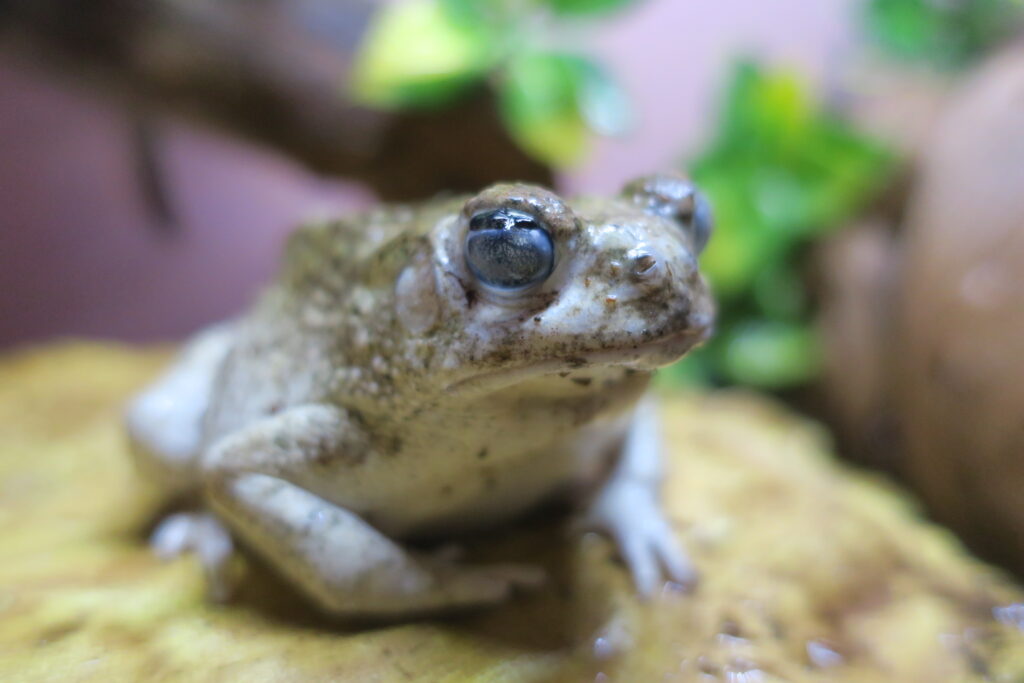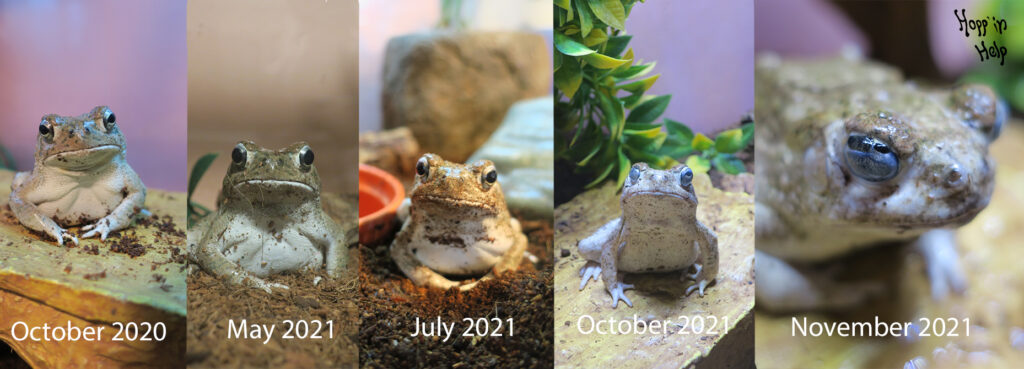Corneal Lipidosis in Toads
**This article is not a research article. It is an inside look through personal experience and work with my exotic vet. It is aimed to be directed towards amphibian owners on how to prevent Corneal Lipidosis and how to identify the signs when it is time to see a vet.**
For research pertaining to Corneal Lipidosis:

Meet my Texas Toad Vinnie! He will be our demonstration of the progression of Corneal Lipidosis. I adopted Vinnie around 2013 with an approximate age of 2-3 years old. In October of 2021, he is a very old man of around 11-12 years old. Vinnie has always been a very chubby toad and enjoyed a variety of bugs. His main diet includes crickets and dubia roaches. Hornworms, wax worms, super worms, and earthworms are given as supplementary treats. It is important to note that mainly wax worms, but also horn worms are very high in fat. However, from my prior knowledge, I believed it was okay for toads to have more fat intake than other herptiles since they are so chunky and are healthier when plump (to a degree of course).
Vinnie also receives supplements, rotating every Friday, he will receive Repashy Calcium Plus multivite. Then the next Friday, a small dose of calcium with D3 because they are shade dwelling species and do not require and can be harmed by too much UVB light. I have shared my care information to give you an inside look and compare and contrast it to your amphibian’s care.
Fast forward to September 20th, 2021. I noticed what appeared to be a small cut on Vinnie’s eye. We had moved on August 15th, 2021, so I was thinking “He’s an old man, probably forgot he has a new set up and bonked his eye on something.” Since him and his tank mate, Frankie, are so old, I tong feed their food to them. As toads age, their vision and general survival senses worsen so I do not want bugs roaming their tank unattended. Crickets and any feeder can actually harm your toads if they are unable to eat them. A perfect example is they may pick at their eyelids when they sleep. The second thing I checked for after noticing his injury was if a feeder had gotten loose. They may have spit one out when I did not see, etc. After a thorough search, I was unable to find any loose feeders and checked off that concern.
Particularly for older Amphibians, something like a vet visit and medicine can do more harm than good. Of course seeing a vet when something goes south is ideal, but when it is something small, I personally suggest heavily monitoring the progression before booking the appointment. I kept Vinnie’s wound clean with a damp q-tip every morning and evening and it seemed to be doing well. However, the first week of October, Vinnie flinched for the first time ever when I misted his tank at night. This was a huge red flag for three reasons; I have had him a very long time and he has never flinched when I mist, his eye may now be painful which can be a number of issues, or he is becoming blind and could not see me bring the mister to his tank. It is now time for a vet appointment.
On October 14th, I took Vinnie in to get a physical. My amazing vet helped me out with a few concerns that I will share since there is little info available on older toads. As you may notice in the progression of photos of Vinnie aging, his fat becomes lower and his backbones become more pronounced. A rule of thumb for herptiles whose spine is showing is that they are underweight. However Vinnie was just about the same weight, if not more, but his spine became more and more visible. (I weigh my animals monthly which I heavily suggest for everyone to do) This is due to aging. The older they get, the more muscle mass depletes, causing their healthy belly fat to hang a little lower and pull the back skin slightly, revealing their spinal structures.

Most importantly was his eye issue. Another observation you may make to Vinnie’s progression of photos is that in the summer of 2021, his eyes became extremely pronounced and almost “large”. This was an early sign of Corneal Lipidosis. Corneal Lipidosis is a syndrome involving fat deposits on the eye. Particularly a lipid (fat) storage disorder where cholesterol deposits accumulate on the corneal tissue. Via my exotic vet, this occurs in older toads for multiple reasons. It is extremely common in older females because as they age, their metabolism slows and the hormones that produce fat for eggs are no longer needed for reproduction but still create this surplus of fat to prep the body for eggs they will most likely not lay. Toads also do not typically live this long in the wild. It is simply a sign of the body aging but the progression can be slowed with the proper preventive care.
My vet did explicitly state that since Vinnie is such an old man, to not deprive him of his favorite treats but to slow down. Horn worms and wax worms should be a very small portion of older frogs and toads diet. While their body still may produce a lot of fat, it is better to not give them even more. Her second suggestion was to give an even more diverse diet. This included adding captive breed silverfish, springtails, and grasshoppers.
With these adjustments, here is Vinnie’s new diet:
Main: Crickets or Dubia Roaches
Given with each meal: An Earth Worm, Grasshoppers, Silverfish, or Springtails
Snacks once a week or less: Super worms/mealworms (cut the head off)
Once a month: A Horn Worm or three small Wax Worms
An awesome place to get feeders suggested by both myself and my vet is Josh’s Frogs!
As I mentioned before, giving an older amphibian medication can cause more harm than good. My vet stated that his eye appears to be healing well with me cleaning it with just water in the morning and evening. She believes the cut/tear was caused by his vision worsening and him bumping the lipid deposit on something, causing it to break open. She did a full exam to determine that his quality of life is good and appears to be in no pain. Regarding me misting him, she agrees with my assumption that he was startled since he can no longer see that well. Her final statement was for me to keep the area clean as it heals, let him know I am coming up to him before doing anything to him or the enclosure, and keeping an eye on the progression. If the eye continues to worsen, she has an order of anti-inflammatories ready to go.
There is no cure for Corneal Lipidosis in amphibians, only preventatives. I hope this article gave you an inside look at the care and prevention of Corneal Lipidosis in older Toads. For questions regarding toad care, feel free to use my contact tab above, or email me at Hoppinhelp@gmail.com. I can not determine if your amphibian has Corneal Lipidosis. Schedule an exam with your local Exotic vet for a diagnosis and medication.
Wishing you all a hoppy life with your toads!

